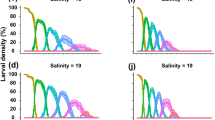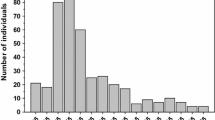Abstract
The terrestrialization success of aquatic organisms requires physiological adaptations, of which water loss restraint, respiratory, and osmoregulatory systems are notably critical. Isopods of the genus Ligia (Oniscidea) have a particular significance for understanding the evolutionary transition of crustaceans from marine to terrestrial/freshwater environments. The main aim of this study was to analyze whether Ligia cinerascens as a supralittoral species has the potential for inland migration and colonization based on its performance of survival under desiccation, submergence, and salinity change. The change of body weight and survival time in desiccation experiments was measured and calculated for the loss of body water and water-specific rate of water loss. The survival of individuals submerged in the seawater (33 ppt) and different salinities of water (0, 10, 30, 50, 70, 90 ppt) was recorded. Salinity acclimation experiments were then conducted with or without food provision. The larger individuals exhibited stronger desiccation tolerance but poorer ability against submergence. Ligia cinerascens could survive the lower water salinity (0, 10, 30 ppt), especially when adequate food was provided. This work suggests the high potential of inland migration and colonization in L. cinerascens based on its strong desiccation tolerance and freshwater adaptation.





Similar content being viewed by others
References
Barnes, D. K., 2002. Biodiversity: invasions by marine life on plastic debris. Nature 416: 808–809.
Broly, P., P. Deville & S. Maillet, 2013. The origin of terrestrial isopods (Crustacea: Isopoda: Oniscidea). Evolutionary Ecology 27: 461–476.
Broly, P., C. Devigne & J. L. Deneubourg, 2015. Body shape in terrestrial isopods: a morphological mechanism to resist desiccation? Journal of Morphology 276: 1283–1289.
Carefoot, T. H. & B. E. Taylor, 1995. Ligia: a prototypal terrestrial isopod. In Alikhan, M. A. (ed.), Terrestrial Isopod Biology. A. A. Balkema Publishers, Rotterdam: 47–60.
Chen, G. X., 1987. The description of two Ligia species. Chinese Journal of Zoology 22: 8–11.
Chen, G. X., 2000. Terrestrial Isopoda fauna of typical zones in China. Acta Zoologica Sinica 46: 255–264.
Davenport, J., 1994. Observations on the behaviour, salinity relations and colour change of Ligia italica from Madeira. Journal of Marine Biological Association of the United Kingdom 74: 959–962.
Dias, A. T., E. J. Krab, J. Mariën, M. Zimmer, J. H. Cornelissen, J. Ellers, D. A. Wardle & M. P. Berg, 2013. Traits underpinning desiccation resistance explain distribution patterns of terrestrial isopods. Oecologia 172: 667–677.
Eberl, R., 2012. Distribution, habitat and food preferences of sympatric high intertidal isopod species Ligia occidentalis and Ligia pallasii (Ligiidae: Oniscidea). Journal of Natural History 46: 1779–1797.
Edney, E. B., 1954. Woodlice and the land habitat. Biological Reviews 29: 185–219.
Edney, E. B., 1967. Water balance in desert arthropods. Science 156: 1059–1066.
Edney, E. B., 1968. Transition from water to land in isopod crustaceans. American Zoologist 8: 309–326.
Gillespie, R. G., B. G. Baldwin, J. M. Waters, C. I. Fraser, R. Nikula & G. K. Roderick, 2012. Long-distance dispersal: a framework for hypothesis testing. Trends in Ecology & Evolution 27: 47–56.
Hadley, N. F. & M. C. Quinlan, 1984. Cuticular transpiration in the isopod Porcellio laevis: chemical and morphological factors involved in its control. Symposia of the Zoological Society of London 53: 97–107.
Hornung, E., 2011. Evolutionary adaptation of oniscidean isopods to terrestrial life: structure, physiology and behavior. Terrestrial Arthropod Reviews 4: 95–130.
Hurtado, L. A., M. Mateos & C. A. Santamaria, 2010. Phylogeography of supralittoral rocky intertidal Ligia isopods in the Pacific region from central California to central Mexico. PLoS One 5: e11633.
Incagnone, G., F. Marrone, R. Barone, L. Robba & L. Naselli-Flores, 2015. How do freshwater organisms cross the “dry ocean”? A review on passive dispersal and colonization processes with a special focus on temporary ponds. Hydrobiologia 750: 103–123.
Itani, Y., 1999. Molecular phylogeography of the genus Ligia in Japanese islands. Konchu to Shizen 34: 39–41.
Itani, Y., 2000. Phylogeography of the genus Ligia (Crustacea: Isopoda) in Japan based on molecular phylogenetic analysis. Kaiyo Monthly 32: 246–251.
Jung, J., H. Eo, H. S. Rho & W. Kim, 2008. Two genetic lineages of sea slaters, Ligia (Crustacea: Isopoda) in South Korea: a population genetic approach. Molecules and Cells 25: 523–530.
Khalaji-Pirbalouty, V. & J. W. Wägele, 2010. Two new species of Ligia Fabricius, 1798 (Crustacea: Isopoda: Ligiidae) from coasts of the Persian and Aden gulfs. Organisms Diversity & Evolution 10: 135–145.
Lee, J. D., 1994. A new mountain slater, Ligia taiwanensis (Isopoda, Ligiidae) from Taiwan. Crustaceana 66: 110–115.
Lighton, J. R. B., D. A. Garrigan, F. D. Duncan & R. A. Johnson, 1993. Spiracular control of respiratory water loss in female alates of the harvester ant Prgonomyrmex rugosus. Journal of Experimental Biology 179: 233–244.
Little, C., 1983. The colonisation of land: origins and adaptations of terrestrial animals. Cambridge University Press, Cambridge.
Markow, T. A. & E. Pfeiler, 2010. Mitochondrial DNA evidence for deep genetic divergences in allopatric populations of the rocky intertidal isopod Ligia occidentalis from the eastern Pacific. Molecular Phylogenetics and Evolution 56: 468–473.
Moore, P. G. & C. H. Francis, 1986. Environmental tolerances of beach-hopper Orchestia gammarellus (Pallas) (Crustacea: Amphipoda). Marine Environmental Research 19: 115–129.
Power, L. W. & D. E. Bliss, 1983. Terrestrial adaptation. In Vernberg, F. J. & W. B. Vernberg (eds.), The biology of Crustacea, Vol. 8. London Academic Press, New York: 271–334.
Raven, J. A., 1985. Comparative physiology of plant and arthropod land adaptation. Philosophical Transactions of the Royal Society B: Biological Sciences 309: 273–288.
Regier, J. C., J. W. Shultz, A. Zwick, A. Hussey, B. Ball, R. Wetzer, J. W. Martin & C. W. Cunningham, 2010. Arthropod relationships revealed by phylogenomic analysis of nuclear protein-coding sequences. Nature 463: 1079–1083.
Richardson, A. & P. B. Araujo, 2015. Lifestyles of terrestrial crustaceans. In Thiel, M. & L. Walting (eds.), The Natural History of the Crustacea, lifestyles and feeding biology. Oxford University Press, New York: 299–336.
Schmalfuss, H., 2003. World catalog of terrestrial isopods (Isopoda: Oniscidea). Staatliches Museum für Naturkunde 654: 1–341.
Schmidt, C., 2008. Phylogeny of the terrestrial Isopoda (Oniscidea): a review. Arthropod Systematics & Phylogeny 66: 191–226.
Schmidt, C. & J. W. Wägele, 2001. Morphology and evolution of respiratory structures in the pleopod exopodites of terrestrial Isopoda (Crustacea, Isopoda, Oniscidea). Acta Zoologica 82: 315–330.
Simčič, T., F. Pajk & A. Brancelj, 2010. Electron transport system activity and oxygen consumption of two amphibious isopods, epigean Ligia italica Fabricius and hypogean Titanethes albus (Koch), in air and water. Marine and Freshwater Behaviour and Physiology 43: 149–156.
Sfenthourakis, S. & S. Taiti, 2015. Patterns of taxonomic diversity among terrestrial isopods. ZooKeys 515: 13–25.
Strother, P. K., L. Battison, M. D. Brasier & C. H. Wellman, 2011. Earth’s earliest non-marine eukaryotes. Nature 473: 505–509.
Taiti, S., M. A. Arnedo & G. K. Roderick, 2003. Evolution of terrestriality in Hawaiian species of the genus Ligia (Isopoda, Oniscidea). In: Sfenthourakis, S., DeAraujo, P.B., E. Hornung & H. Schmalfuss (eds), Koninklijke Brill NV, Leiden: 85–102.
Todd, M. E., 1963. Osmoregulation in Ligia oceanica and Idotea granulosa. Journal of Experimental Biology 40: 381–392.
Tsai, M. L., C. F. Dai & H. C. Chen, 1997. Responses of two semiterrestrial isopods, Ligia exotica and Ligia taiwanensis (Crustacea) to osmotic stress. Comparative Biochemistry and Physiology Part A: Physiology 118: 141–146.
Tsai, M. L., C. F. Dai & H. C. Chen, 1998. Desiccation resistance of two semiterrestrial isopods, Ligia exotica and Ligia taiwanensis (Crustacea) in Taiwan. Comparative Biochemistry and Physiology Part A: Physiology 119: 361–367.
Vittori, M. & J. Štrus, 2014. The integument in troglobitic and epigean woodlice (Isopoda: Oniscidea): a comparative ultrastructural study. Zoomorphology 133: 391–403.
Warburg, M. R., 1993. Evolutionary biology of land isopods. Springer, New York: 159.
Waterkeyn, A., B. Vanschoenwinkel, S. Elsen, M. Anton-Pardo, P. Grillas & L. Brendonck, 2010. Unintentional dispersal of aquatic invertebrates via footwear and motor vehicles in a Mediterranean wetland area. Aquatic Conservation 20: 580–587.
Wilson, W. J., 1970. Osmoregulatory capabilities in isopods: Ligia occidentalis and Ligia pallasii. Biological Bulletin 138: 96–108.
Wilson, G. D. F., 2008. Global diversity of isopod crustaceans (Crustacea; Isopoda) in freshwater. Hydrobiologia 595: 231–240.
Yamanishi, R., 2011. Morphological characters of Ligia cinerascens Budde- Lund, 1885 (Crustacea: Isopoda: Ligiidae) newly recorded from Osaka Bay, the inland sea of Japan, compared with those of from Hokkaido and of L. exotica Roux, 1828 from Osaka Bay. Bulletin of the Osaka Museum of Natural History 65: 1–8.
Yin, J., D. Pan, C. He, A. Wang, J. Yan & H. Sun, 2013. Morphological and molecular data confirm species assignment and dispersal of the genus Ligia (Crustacea: Isopoda: Ligiidae) along northeastern coastal China and East Asia. Zoological Journal of the Linnean Society 169: 362–376.
Zachariassen, K. E., 1991. Routes of transpiratory water loss in a dry habitat tenebrionid beetle. Journal of Experimental Biology 157: 425–437.
Acknowledgments
This study is supported by the Key Laboratory for Ecological Environment in Coastal Areas, State Oceanic Administration (No. 201109). Two editors Luigi Naselli-Flores and Diego Fontanet are gratefully acknowledged for their suggestions on the logical structure and general framework of this paper. We thank two anonymous reviewers who provided helpful suggestions to an early draft of this paper. We also thank Dr. Chris Fouche (Department of Agriculture, Forestry and Fisheries, Republic of South Africa) for elaborate work on the improvement of language expression.
Author information
Authors and Affiliations
Corresponding author
Additional information
Handling editor: Diego Fontaneto
Rights and permissions
About this article
Cite this article
Zhang, P., Sun, J., Wang, S. et al. Influences of desiccation, submergence, and salinity change on survival of Ligia cinerascens (Crustacea, Isopoda): high potential implication for inland migration and colonization. Hydrobiologia 772, 277–285 (2016). https://doi.org/10.1007/s10750-016-2673-2
Received:
Revised:
Accepted:
Published:
Issue Date:
DOI: https://doi.org/10.1007/s10750-016-2673-2




